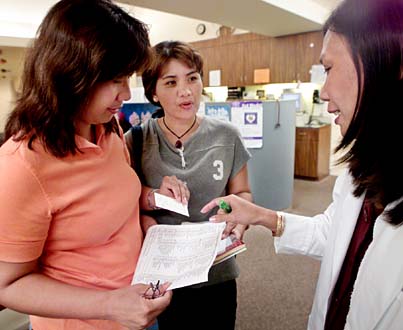
GEORGE F. LEE / GLEE@STARBULLETIN.COM
Rosemarie Madriaga, center, who is five weeks pregnant, consulted nurse Marilou Tagata-Mindo as Madriaga's sister-in-law, Mel Godoy, read her paperwork at the Kalihi-Palama Health Center.
Health care for all
is elusive goalA conference later this month
will consider how to help those
who lack insurance
Rosemarie Madriaga and Bonifacia Cervano waited for help this week alongside other uninsured patients in the crowded waiting room at the Kalihi-Palama Health Center.
Madriaga, 32, five weeks pregnant, was there for her first obstetrics checkup.
Cervano, 64, needed medicine for her blood pressure. She had been on the state's Med-QUEST program but learned last weekend she and her husband had been cut off when she went to a pharmacy to refill a prescription, she said.
Madriaga and the Cervanos are among an estimated 120,000 isle residents without health insurance -- the focus of the Hawaii Uninsured Project's "Coverage for All" conference Oct. 29 at the Hilton Hawaiian Village.
"When we're talking about the uninsured, it's not like we're talking about them and us," pointed out Jacque Smith, the project's associate director of community relations and grant management. "I could easily be laid off my job tomorrow and lose my health insurance."
Working people who don't qualify for health coverage from employers, mostly because they're part-time employees, comprise the largest percentage of the uninsured. Others are sole proprietors, independent contractors or temporary hires.
Madriaga's husband, Romeo, has insurance from his employer at the Arcadia but can't afford to add his wife to the plan, said Mel Godoy, Madriaga's sister-in-law, who accompanied her to the clinic.
Romeo came here in 1995 and petitioned to bring his wife here as an immigrant after marrying her in the Philippines. She arrived in July.
She can't qualify for QUEST until she's been a resident for five years but learned she may be able to get care under the Hawaii Immigrant Health Initiative.
Marilou Tagata-Mindo, triage nurse at Kalihi-Palama Health Center, tried to sort out Cervano's problems.
"When I got medicine two months ago, I had medical (coverage)," Cervano said, speculating that she lost it because of a mix-up in paperwork.
Workers at the health center can help her reapply for coverage, Tagata-Mindo said.
Smith noted that there about 25,000 adults who meet income the requirements for the state's QUEST health plan but they can't get coverage because the state Department of Human Services has already reached its quota of 125,000 clients.
The uninsured population has grown from about 5 percent in the 1980s to nearly 10 percent in 2001, according to the Hawaii Uninsured Project. And the burden of care falls mostly on hospitals and 10 community health centers, which receive little or no reimbursements for providing care.
The health centers last year treated more than 27,000 uninsured patients -- a 20 percent hike from 2001, according to the Hawaii Primary Care Association.
Bad debt and charity care cost the Healthcare Association of Hawaii's 24 hospitals and three nursing facilities $389 million from 1998 to 2002, according to an Ernst & Young audit.
Annual losses for the 12 public hospitals from uncompensated care and bad debt total $12 million to $14 million, the Hawaii Health Services Corp. says.
With concerns growing about the uninsured, the Hawaii Medical Service Association started the Hawaii Uninsured Project in 2000 to study the issue. The project's management has shifted to the independent Hawaii Institute for Public Affairs and more than 60 organizations are involved.
Lack of health insurance affects everyone, said Joan White, Hawaii Uninsured Project executive director. "The Coverage for All conference is a huge step toward our ultimate goal of expanding coverage for Hawaii's people." The HMSA Foundation provided $40,000 and Kaiser Permanente Hawaii $10,000 for the conference.
The state Department of Health has received more than $2 million in federal and foundation grants to address the problem of the uninsured through Dec. 31, 2005.
Five groups are looking for solutions and a sixth group is studying the Hawaii Prepaid Health Care Act. They will present reports at the conference from 7:30 a.m. to 3 p.m. in the Tapa Ballroom. Gov. Linda Lingle also will discuss her vision for health care in Hawaii and government's role.
University of Hawaii Social Science Research Institute scientists will discuss research analyzing the uninsured, costs and benefits of different coverage, barriers to care and the impact on the community.
Gerard Russo, UH health economist and principal investigator, said some people are frustrated because research progress is slow. "But it's very complex and hard to get quick answers," he said. "We believe in steady high-quality progress and try to avoid major mistakes and omissions which would later haunt policymakers."
Smith said, "There is a mounting urgency coming from all sectors" to deliver recommendations but the problems are too complex for simple solutions.
"The most important question that we need to be asking our friends, our families, our leadership is this: Is it our responsibility to provide access to health care for the neediest and most helpless in society?"
